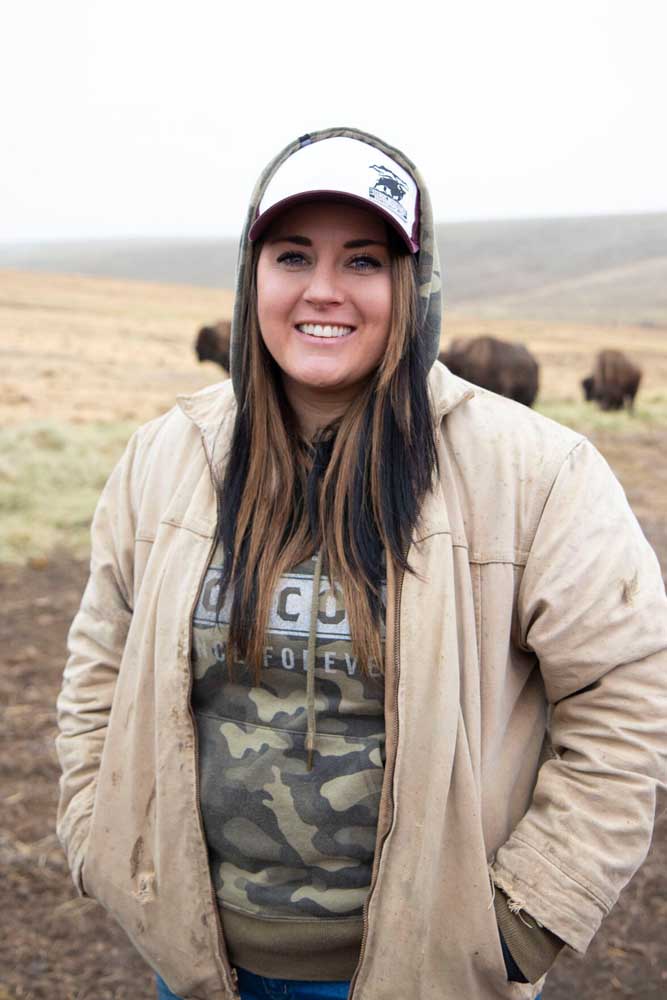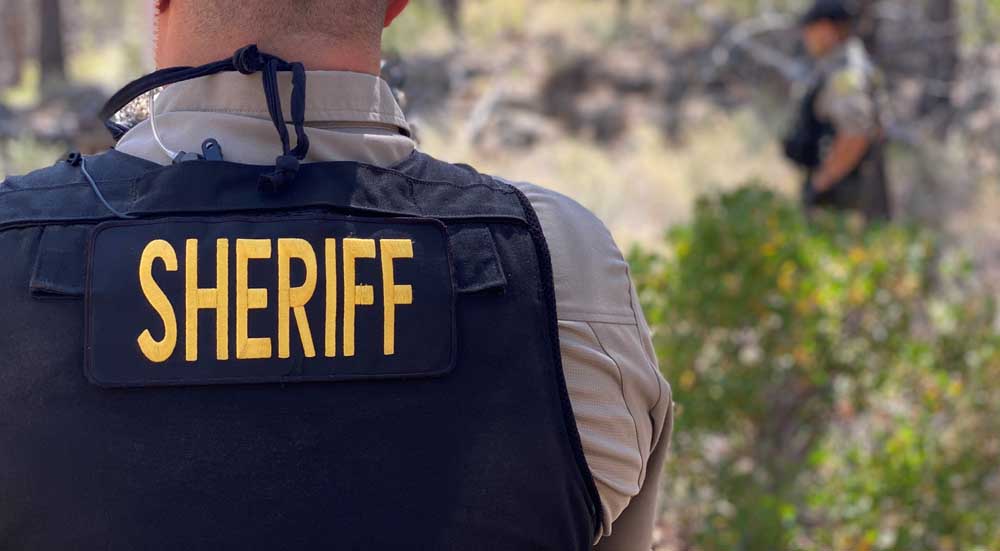BEEF TO BISON: Why a family ranch pivoted from raising cattle to buffalo
Published 3:00 am Tuesday, May 2, 2023

- Theresa Stangel
ENTERPRISE — From their vantage point atop a wooden fence platform, Bob Stangel and his adult daughters, Marta and Theresa, watched as bison on the hills in front of them leapt with the playfulness of goat kids.
“There they go,” said Marta, 27. “They like to run.”
A smile tugged at the corner of her mouth.
The Stangels run a bison ranch near Enterprise. To the north lie sprawling prairies and mixed conifer forests; to the south, the Eagle Cap Wilderness. On a clear day, the Wallowa Mountains — often called the “Alps of Oregon” — are visible, creating a dramatic backdrop behind the ranch.
The Stangels are part of a niche industry: raising American bison, commonly called buffalo. Compared to the U.S. beef industry, which slaughters about 125,000 head of cattle per day, the approximate number of bison harvested in the U.S. and Canada was just 69,000 for the entire year of 2020.
Yet consumer demand for bison has been growing, and many ranchers, including the Stangels, have found raising bison to be more profitable and economically sustainable than raising cattle.
“I couldn’t have asked for a better family business,” said Theresa, 32.
Raising bison also helps with species conservation. Before 1900, North America had between 30 million and 60 million bison. Today, the North American herd is about 362,400. It might seem counterintuitive that raising buffalo for meat would increase their population, but the American Bison Association says production contributes to species restoration. As consumers demand more bison meat, ranchers are incentivized to raise bison, building strong genetic lines and boosting the overall population.
According to USDA’s 2017 Census of Agriculture — the most current data available — more than 183,700 bison live on 1,775 private ranches and farms across the U.S., up about 13% from the private bison population in 2012.
The Stangels raise 500 to 600 bison annually.
The family, however, has not always produced bison.
Pivoting from cattle
In 1958, Bob Stangel’s parents bought the property near Enterprise and established a cattle ranch.
When Bob and his brothers, Joe and Dick, grew up, they built on the foundation their parents had started, forming a partnership with subdivisions: dryland grain growing, cattle ranching, and operating a heavy equipment and machine shop.
For Bob, continuing to farm felt natural: “I grew up in it. I decided that’s what I wanted to do.”
His tone was soft and thoughtful.
Whether he wanted to continue raising cattle, however, was less certain. As the cattle market jolted up and down, Bob grew weary of the fluctuating prices and instability. He wondered if raising livestock for a more niche market might bring greater stability.
In 1979, after graduating from college, he decided to find out. Bob and his brother Joe bought six bison heifers and two bison bull calves from a ranch in Northeastern Colorado. Over the next decade, they gradually weaned themselves off cattle production as they built up their bison herd and markets. By 1987, they had sold the last cattle and completely pivoted to raising bison.
But raising bison had its own set of challenges, and the family had to adapt to the new species.
Theresa recalls she wasn’t always enthusiastic about her dad’s bison business.
“In fourth grade, I thought: ‘I don’t want bison. I want cattle like everyone else,’” she said.
Theresa has since come to appreciate the beasts, which are in many ways different from cattle.
Raising bison
Bison, which have been genetically manipulated less than domesticated cattle, have a wilder streak. They snort and grunt like pigs, stick together with a fierce herd mentality and are less likely to face wolf depredation because wolves tend to prefer less aggressive prey.
Bison generally give birth easily on the range with little or no human intervention, dropping small yet hardy calves weighing 40 to 50 pounds each late April through May.
Bison also grow more slowly than cattle, reaching maturity as meat animals at 20 to 30 months, according to the National Bison Association.
The Stangels’ bison are grass-fed and grass-finished. During the dry months, they roam the rangeland and pastures. During the wet months, they live in hillside paddocks and eat hay.
The Stangels strategically rotate the bison on the landscape, leaving time for the ground to rest between rotations.
“The land is gonna be there longer than we are,” said Bob. “We need to take care of it.”
Bob says the bison don’t need human caretakers; they’re tough and could make it on their own. Because the Stangels want to handle the bison, however, they need to understand and accommodate the animals.
By observing the bison, Bob has tried to learn their ways and adapt his operation and infrastructure to suit them and control their behavior.
For example, he noticed that bison tend to seek higher ground, so he designed penned walkways that slant upward in the direction he wants the bison to go — such as toward holding chutes for vaccination and dehorning.
Don’t fence me in
Bison are powerful jumpers, so the Stangels have had to build wooden fences and corrals significantly taller and sturdier than fencing used for cattle.
If the bison escape, rounding them up is difficult because they are rowdy.
“If a cow gets out, it’s not great. If bison get out, it’s like: Oh, no,” said Theresa.
She recalled one occasion when every family member was out of town and the bison escaped.
“I swear they knew,” said Theresa.
“They’ll take advantage of you. They’re smart,” said Marta.
As Marta spoke, tiny snowflakes fell from the April sky, catching in her hair and melting on her coveralls.
Despite their brute nature, bison have vulnerabilities. One of their greatest threats comes from mycoplasma bovis, a disease that has ravaged herds across the Great Plains and the West. Researchers have yet to find a highly effective treatment. Although the Stangels vaccinate against mycoplasma, it still crops up sometimes. A few summers ago, they lost about 100 bison to the infection.
The Stangels also face challenges common to ranchers across other agricultural industries, including higher prices for inputs such as hay and fuel.
Despite these difficulties, Marta and Theresa say they are committed to the work.
Why eat bison?
Theresa said she enjoys educating consumers about the differences between bison and beef.
Bison carry their fat mostly on the outside of their muscles as a protective layer against the cold rather than marbled into the muscles. As a result, the meat is leaner. When cooked properly, bison meat is tender, juicy and nutrient-dense. Some consumers describe bison as having a lighter, slightly sweeter flavor than beef with a subtle freshness or grassiness.
The Stangels also run a program called the Stangel Bison Club, in which they send subscribers a 10-pound box of farm-direct bison once a month, along with recipe cards.
Kokanee Inn, a bed and breakfast place in nearby Joseph, Ore., subscribes to the bison club. The innkeepers recently served guests pineapple jalapeno bison tacos based on a recipe by Theresa Stangel.
“We are thrilled to be able to access local bison. It’s special for us and our guests,” said Michelle Britt, co-owner of Kokanee Inn.
In addition to the meat, the Stangels also sell cleaned skulls and hides, and a local dairy goat producer uses bison tallow as an ingredient in goat milk soap.
What’s next?
Looking to the future, the Stangels say they plan to keep raising bison and educating people about these remarkable animals.
The ranch recently received a $250,000 value-added producer grant from USDA to help cover sales and marketing costs as the Stangels continue to expand their brand.
Forty-four years after bringing the first bison to the ranch, Bob Stangel still enjoys watching the beasts frolic on the Wallowa landscape. His daughters say they feel lucky to have been raised in a ranching family and to be able to continue producing bison.
“We are very, very fortunate,” said Theresa.
Bison, which have been genetically manipulated less than domesticated cattle, have a wilder streak. They snort and grunt like pigs, stick together with a fierce herd mentality and are less likely to face wolf depredation because wolves tend to prefer less aggressive prey.








